#irishsailors – With the coldest, wettest and windiest July finally put astern, Irish sailors of all ages competing at every level at venues near and far – sometimes very far - keep their fingers crossed that summer will manage to appear before the season is out. But even if 2015 continues to be only a dark (or pale), cold, damp and blustery misinterpretation of what a summer should be, sailing goes on at home and abroad. The spirit of competition, with a gameness for almost everything the weather throws at it, is found at every level. W M Nixon casts an eye over our July experiences at home and abroad.
Ireland's incomparable southwestern seaboard is where West Cork morphs into Kerry somewhere down towards Dursey Island amidst scenery so heart-stoppingly beautiful that it should be a controlled substance. And it is usually thought of as being indented with four magnificent inlets or rias which provide endless delight and many anchorages for cruising folk.
There are the three main rias – Dingle Bay, the Kenmare River, and Bantry Bay, while down south is the little sister, Dunmanus Bay. Bounding them and dividing them, we thus have five great peninsulas – Dingle, Iveragh aka The Ring of Kerry, Beara, Sheep's Head, and the land down to the Mizen.
But it could be argued that in reality there's a sixth peninsula even further to the south, also jutting into the Atlantic. However, it's fragmented, as its components include the Fastnet Rock, Cape Clear and Sherkin Island. Nevertheless this means that in effect Roaringwater Bay is the sixth great ria. It's sometimes seen as such by visitors, though admittedly for locally-based sailors, Mizen Head is very much the local Cape Horn, and they feel little relationhip to the big country beyond.
But having persuaded a select few to agree with this proposition, let me muddy the waters further by suggesting that there's actually a seventh great Irish peninsula. It juts southwestwards in the approved style. It has rugged headland and half a dozen islands off it. It's full of delightful little villages and tiny ports of great character. There's a strong local tradition and ancient history of religious mysticism and pilgrimage destinations. And finally to prove its Irish credentials, they grow absolutely wonderful potatoes. So here are some photos of that seventh great peninsula, and you can rack you brains as to where precisely it is.
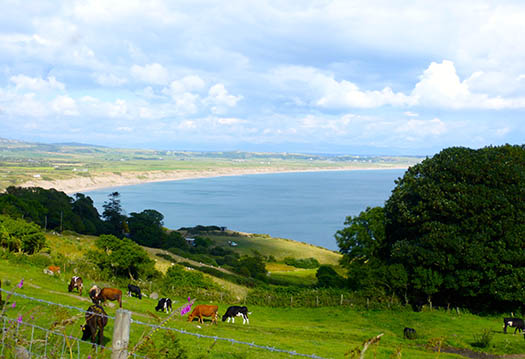
Classic Irish scenery with cattle where shelter and good grass can be found, a fine stretch of beach, and beyond it the fertile sandy fields where superb potatoes can be grown, with purple mountains in the distance. Photo: W M Nixon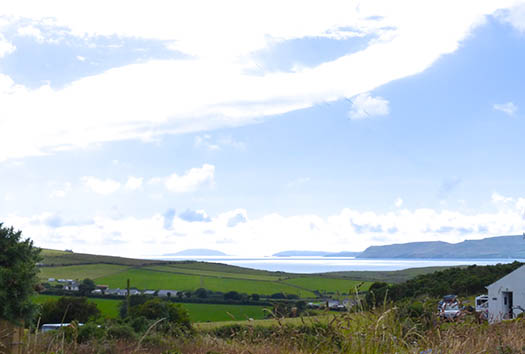
Is this Ireland's seventh great peninsula? It thrusts southwestward in classic style, with rugged islands beyond. Photo: W M Nixon

Furthest seaward is a sacred island, still a place of pilgrimage. WM Nixon
Top marks to anyone who has spotted that this is actually the Lleyn Peninsula in northwest Wales. When you go on far southwest down it, beyond Abersoch into the hidden country and coastline towards Bardsey Island, on a good day you could be in Kerry or West Cork. And like the great peninsulas of Kerry, it helps to provide shelter for the bays within it, such that, in reasonable weather, Tremadoc Bay between Abersoch and Portmadog - with the useful harbour and marina of Pwllheli between them and the magnificent backdrop of Snowdonia beyond - provides a sailing venue of world class.
But as young Irish Optimist sailors have been finding this past fortnight in racing off Pwllheli, the weather of July 2015 has been not at all reasonable. One depression after another has swept in from the Atlantic. And while we were able to report that the astonishing Volvo Dun Laoghaire Regatta enjoyed Ireland's East Coast effect in that clouds from the west had shed all their rain by the time they came over Dublin Bay, such clouds in travelling with increasing rapidity towards the Lleyn and Tremadoc Bay on the lee side of the Channel gather up the sea's moisture to such good effect that they arrive as rain and – worse still for a sailing event – clinging fog.
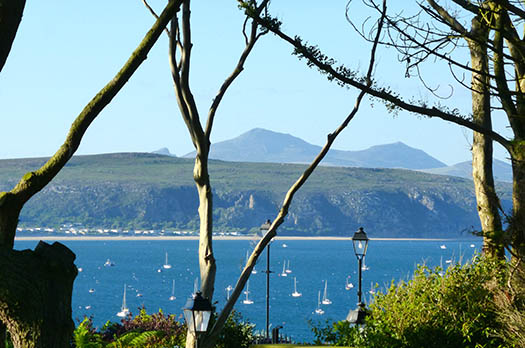
The anchorage off Abersoch on Tremadoc Bay. The large tidal range makes the provision of secure and convenient berthing difficult but once you're afloat the sailing can be superb if the weather is reasonable. Photo: W M Nixon
So although we've popped in a photo of what Tremadoc Bay can look like in normal conditions, our reports here on the Magic Marine Optimist Europeans followed by the current Volvo British Open Championship, both being staged by Stephen Tudor's team at Plas Helli in Pwllheli, have experienced distinctly rugged conditions, though the going has become a bit less hectic in recent days, with two Fingal helms, Peter Fagan of Skerries and James MacMahon of Howth, showing best of the Irish.
Those racing in North Wales have only had to deal with standard variations – albeit very tough – of North Atlantic conditions, but in Japan the Irish 420 squad racing in the Worlds were part of an enormous regatta that saw a day or two entirely lost as Typhoon Nangka whirled past to the eastward.
They don't expect typhoons to upset sailing programmes on Rutland Water in the heart of England, but research has shown that tornadoes – most of them very small - are much more common in England than had been formerly thought. However, while the waters of Rutland have been well ruffled by Tornadoes, it's boats the former Olympic catamaran class which have been doing it. But they were kept well clear for July's big team racing event there, where both of Ireland's teams were provided from Schull, with the ever-enthusiastic David Harte leading two young squads who were very much into the frame, but narrowly failed to secure that top place on the final podium.
If we allowed the phrase "pipped at the post" to slip into this narrative, it will be flogged to death by the end, but it's the only apposite word for the runner-up result achieved by Ewan McMahon of Howth in the Laser Radial Youth Worlds in Portugal, where for a brief but glorious time he seemed to have won the Gold, only to be relegated to Silver on the convoluted outcome of a protest after the final race.
The Topper Worlds in Italy have drawn in a fleet of 180 boats, which is beyond most Irish sailors' imagination. But Geoff Power of Dunmore East was able for the challenge, and the Waterford Harbour SC helm was so well in the hunt that at one stage a medal was likely, but a the very last he missed bronze by one point.
The 29er may be a two-person boat, but anyone campaigning one of these little flying machines out of Crosshaven is ploughng a lonely furrow, as there's no class of them at RCYC. Despite that, the Durcan brothers very determinedly continue to rise through the 29er ranks in Ireland, and they went to Medemblik in The Netherlands for the Euros a fortnight ago, and were the youngest to qualify for the Gold Division, placing 25th overall and keen for more competition.
This youthful yet almost solitary pursuit of sailing performance has been in stark contrast with the highlights of adult sailing this past week, where the more senior sailors have been running the entire gamut from the Bicentenary Regatta of the Royal Yacht Squadron in Cowes to the Cock of the North trophy for the National 18s – some with their new Phil Morrison boats – at the Royal Cork.
Even the sacred ceremonies of the RYS are not immune from the adverse effects of the malicious weather. Indeed, down Solent way where their summer is usually more established than we get in Ireland, last weekend's two day America's Cup event off Ben Ainslie's new base in Portsmouth saw the second day blown out on Sunday. But the four time Olympic Gold Medallist had done enough on the first day with a first and a second to come out of it as winner, though the New Zealanders claim to have had the best of it for five of the eight legs sailed. Depends how you slice it, really.
As for the RYS festivities, this bad weather continued into Monday when the first day of Squadron racing was cancelled, but on Tuesday they got away in a very stiff breeze, and though George David's new Rambler 88 carved her way into quite a lead, on handicap she was beaten into second place by Hap Fauth's 72ft Bella Mente.
It's an invitation event for very senior senior clubs, and Anthony O'Leary with family and friends is representing the Royal Cork YC. Our header photos show just why the Ker 40 Antix of Munster is such a demanding boat to sail. But if you wonder why they don't have more footholds and footstraps, the thinking is that when they're not helping people to stay in place, they'll trip them up, so they keep her clean and you hang on as best you can.
The summer suddenly arrived in the Solent after mid-week, and Antix revelled in it to take the class win on Thursday. But the arrival of classic Solent champagne sailing meant the real stars of the show, the giants of the J Class, were able to race in all their glory, and a busy skipper of our acquaintance multi-tasked to get us some pix on his iPhone.

Endeavour with her original rig configuration. Charles E Nicholson's first effort at a J Class design has resulted in a boat in which the hull overhang at the stern is less than it is at the bow, which doesn't look at all right.
Time was when it was accepted that we'd never see the likes of the J Class again, but now eccentric millionaires – they just have to be eccentric – are even building new J Class boats to designs which were proposed in the class's original heyday in the 1930s, but were never built.
With this new flowering of the class, we can allow ourselves to be a bit more demanding in looking at J Class designs. For instance, everyone swoons about Endeavour from 1934. But to my mind – which seldom has reservations about the usually excellent designs of Charles E Nicholson – Endeavour doesn't look at all right. Her counter is excessively tucked up and short, while her bow is much too long – she looks snouty. It may be that, in this his first take on the J Class rule, Nicholson reckoned the best exploitation of the new rule was obtained by such a shape. But it resulted in a boat which seems to be back-to-front in the overhangs department.
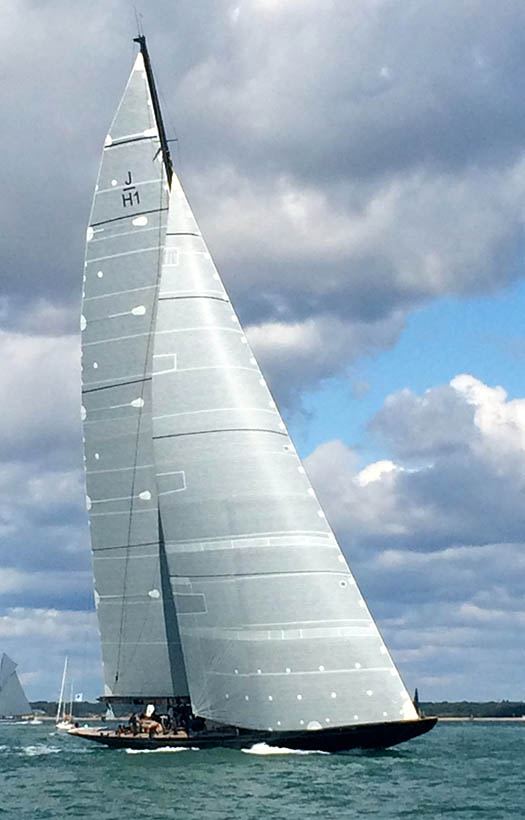
J Class Lionheart, the first Dutch-numbered boat of this unique type. Photo: AOL
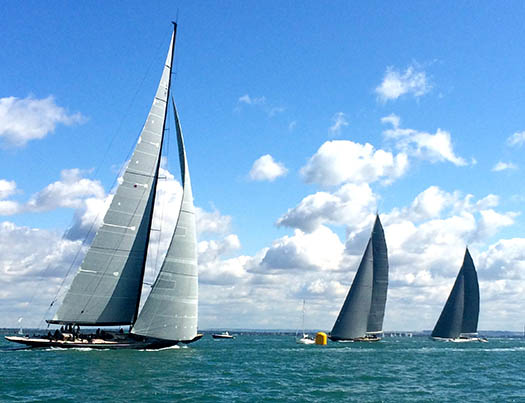
Lionheart's counter stern seems more sweetly aligned than that on the Endeavour design. Photo: AOL
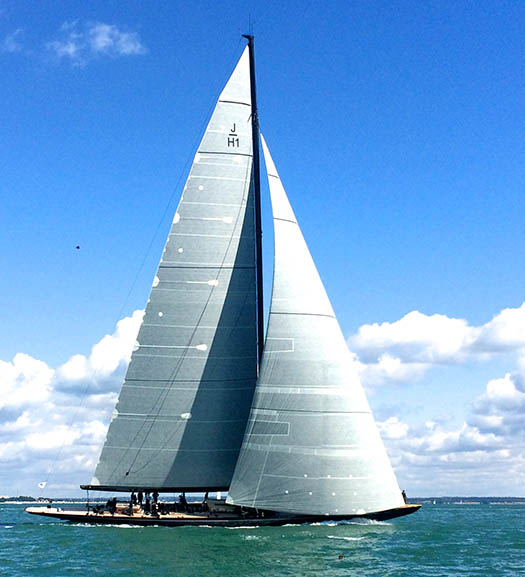
Jurassic Park. The dinosaurs are making a comeback....the mighty sloops of the J Class are welcomed by the summer in Cowes after the bad weather early in the week had moved on. Photo: AOL
The presence of the newer Dutch-built Lionheart in Cowes suggests that a tucked-up counter is not after all essential, and certainly the fastest J of them all in the 1930s, the mighty Stephens/Burgess-designed Ranger of 1937, had a healthier stem-to-counter relationship.
But enough of unattainable giants. We conclude by turning to Cork, where the Nationals 18s have made accessibility the keynote with their latest non-commercially-created Phil Morrison design, which enables new boats to be bought for much less than would be the case had the design been developed by a normal profit-seeking dinghy-building firm.
The photo says it all. You don't have to be off the wall to be happy among the head-bangers of the National 18s, but it certainly helps. And if more senior readers have found it slightly depressing to read of the youthful energy of Ireland's junior squad as they merrily yet determinedly continue their campaigning in all parts of the world whatever the weather, here's a thought which might become a useful class slogan: You'll soon feel young again if you race a National 18.

"You'll never be old if you race a National 18" Photo: Bob Bateman































































